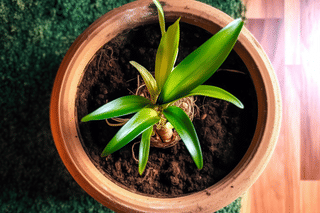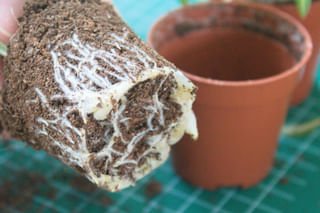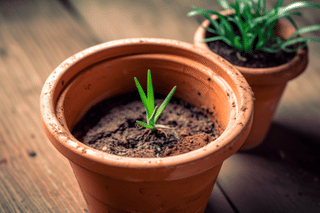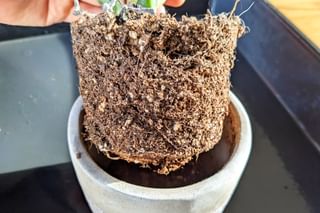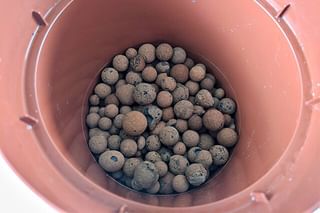Does using a pot that's too large harm your plants?
Learn the truth about whether a large pot is harmful and what the effects of overpotting are on your houseplants. Get tips on optimal pot sizes to promote healthy growth and what to do if your plant is overpotted.
A lot of us, in our excitement to give our plants plenty of room to grow, have gotten caught up in the overpotting trap. But guess what? Using a pot that's too big for your plant could harm its health. I know it sounds counterintuitive: more space should mean more growth, right? Well, turns out it's not always that simple.
In this blog post, we'll break down the idea of overpotting, learn about its potential harm to your houseplants, and share practical solutions to prevent and fix overpotting problems.
Let's dive right in, shall we?
How a plant absorbs water
Plants use their strong root system to soak up water quickly from the potting mix. These roots act like sponges to draw in water for the plant's hydration needs. The bigger the roots and leaves, the more water a plant can absorb.
On the other hand, small plants have smaller roots that can only take in a limited amount of water. So, when you plant a small plant in a pot that's too big, the potting mix stays wet for a long time. This creates a waterlogged environment that can lead to root rot, similar to overwatering a plant.
So even if you water your plant properly, use a pot with a drainage hole, and let the top of the soil dry out before watering again, you could still overwater your plant by picking a pot that is too large.
How overpotting harms plants
Many plants need a wet-dry cycle to thrive. This wet-dry cycle does something incredible to the soil to keep your plant healthy. Healthy soils are permeable and have about 25% air. Permeable means that something allows liquids or gases to pass through it. These potting mixes allow the water to slowly drain to the bottom of the pot while keeping enough moisture behind to water your plant. But why is this important? Well, plant roots need oxygen.
When water moves through the soil, it pulls air into the soil for the roots. If the growing medium stays too wet for too long, roots don't get air because there's no free oxygen in waterlogged conditions. This causes roots to turn black and rot. This is why it's so important to keep the soil well-drained for healthy roots.
So waterlogged soil doesn't just drown the roots of your plant, it also doesn't let them breathe. If you need help to recognize root rot, have a look at How do you recognize root rot on your houseplant?.
Overpotting symptoms

When a plant is overpotted, overwatered, or has its pot sitting in water for too long, it shows some signs. These can include leaves that start to wilt or droop, turning yellow, and eventually browning and falling off. The plant's growth might also be stunted, and it may not look healthy overall.
Also, if the potting mix is too wet, it may become excessively soggy and start to decompose. This can create a damp indoor environment that encourages the growth of fungus gnats, those annoying little flies that tend to hang around overwatered indoor plants.
Why do plants wilt and droop from too much water?
Plants absorb water through their roots and take in carbon dioxide from the environment. Through a process called photosynthesis, they convert these components into carbohydrates and sugars.
Usually, a large root system means the plant can support more leaves than if the root system is smaller. These roots have to absorb nutrients to feed the stems and leaves of the plant.
However, if the roots are damaged, they can't absorb enough water to keep all the leaves healthy. As a result, some leaves may start to wilt, turn yellow, and eventually fall off.
The difficult thing about this is that it's often mistaken as dehydration, but, in this case, it means the plant is lacking water because its roots are not working properly. If you were to add more water it'll make the problems worse instead of solving them.
Prevent overpotting problems
Now that we understand the issues with overpotting, let's focus on preventing it for your plants. We'll discuss a few practical tips you can easily implement to avoid overpotting and keeping your plants healthy.
Choosing appropriate pot sizes
The easiest tip so to get a pot that fits the size of your plant. If the pot is the right size, you're not overpotting your plant. Avoid overly large or deep pots. The general rule in gardening for repotting plants is to pick a new pot that's only one size larger than the current pot.
For example, a plant in a 10cm (4 inch) pot should be repotted into a 12cm (5 inch) pot and then into a 15cm (6 inch) one. As you can see, every time we repot a plant, we only go up one size. For some moisture-loving plants, you can get away with skipping a size, but I recommend sticking to 1 size every time.
Repotting at the right time
One of the issues of overpotting is that your plant is too small for a pot and won't absorb the moisture quickly enough. But if you time your repotting right, you can help your plant to grow roots more quickly and it'll be able to absorb the moisture quickly enough.
The best time to repot is in early spring or autumn when weather conditions are mild, and plants can grow actively, so they'll grow their roots deeper in the pot.
Using Tall Pots Effectively
If you're aiming for a tall pot just for its looks, don't fill the entire depth with soil. This can harm shallow-rooted plants. Instead, fill the bottom half with a light, sturdy material like Leca, which is a red-brown volcanic rock with air pockets.
You can also place the plant in a regular-sized plastic pot and set it on an upside-down plastic or terracotta pot inside the fancy tall pot to even out the height. This won't expose your plant to the large amount of potting soil in the pot, so you're not putting it at risk of overpotting and root rot.
How do you rescue overpotted plants?
Now that you know how to prevent overpotting, let's talk about helping out your houseplants who may already be struggling. Let's look at some easy and effective strategies to get your plants back on track.
To help your plant get back to health, there are 2 things you have to do:
- Trim any rotting roots
- Remove any decomposed soil from the roots of your plant
Now that you've taken a few steps to prevent/resolve root rot on your plant, there are a few things you can do to keep your plant healthy going forward, like:
- Repot your plant into a smaller pot filled with fresh potting mix.
- Add more (larger) plants with the plant in the large pot. More plants will help to absorb the moisture more quickly.
- Add Leca, stones/bricks, or upside-down plastic pots to the bottom of the pot to make it smaller on the inside.
- Improve drainage by adding some perlite or grit to your potting mix. This can help improve drainage, reducing the risk of waterlogging and root rot caused by overpotting.
To sum it up, it's super important to properly handle the risks of overpotting to keep your houseplants healthy. By knowing the signs and ways to prevent it, you can make sure your plants thrive in their pots.
Thank you for reading this post! I hope it helps you to keep your plants healthy and beautiful! If you're looking for more guides on specific plants, you can always request a plant guide to get a guide for the plant you have trouble with.
Test your plant care knowledge
Quiz completed!
Want to learn more? Sign up for my newsletter to receive free tips in your inbox!
Sign up now!